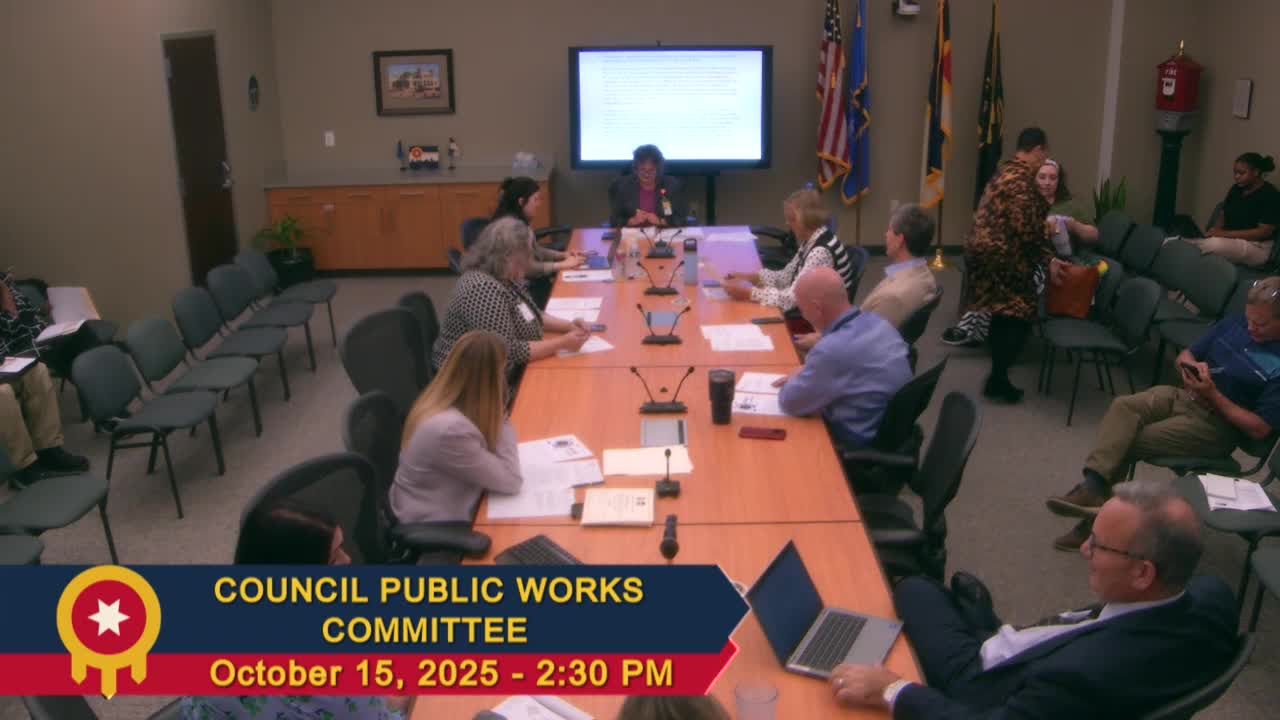City staff present corrections to Perryman Ditch drainage maps; 29 structures removed from regulatory floodplain
October 15, 2025 | Tulsa, Tulsa County, Oklahoma
This article was created by AI summarizing key points discussed. AI makes mistakes, so for full details and context, please refer to the video of the full meeting. Please report any errors so we can fix them. Report an error »

City staff told the Public Works Committee they are asking the council to adopt corrected map panels for the Perryman Ditch master drainage plan and the City of Tulsa regulatory floodplain and drainage-sensitive areas atlas.
Joan Gosvick of the city’s Water and Sewer Department said the master drainage plan and more precise hydraulic modeling identified parts of the mapped area that drain less than the 40-acre threshold the city uses when mapping regulatory floodplain. “They’re removed because the area that drains to them is less than 40 acres. So they will no longer be part of the drainage sensitive area,” Gosvick said.
Gosvick said the revision removes 29 structures from the city regulatory floodplain and 32 structures from the drainage-sensitive area; she also said the updated modeling changed base flood elevations and therefore could reduce required freeboard for some properties. She said the regulatory floodplain carries a “substantial improvement” threshold (commonly enforced using a 50% substantial-improvement test), while the drainage-sensitive area retains most development requirements but does not trigger the substantial-improvement restriction.
Committee members and residents asked whether removal from the mapped regulatory floodplain means the properties will no longer flood. Staff answered that mapped changes reflect the 100-year model used for regulatory mapping and do not guarantee a property will never flood. Staff noted property owners may still purchase flood insurance and could be eligible for the city’s flood-insurance discount even if removed from the regulatory floodplain; however, actuarial ratings and premiums may change because the mapped risk is lower.
Councilors pressed staff on downstream problems identified by the Perryman Ditch master drainage plan, which the committee said highlighted large capital needs. One speaker summarized city stormwater capital needs as roughly $2.4 billion in the current CIP inventory and said annual available stormwater capital is about $5 million to $10 million, meaning large-scale projects such as holding-ponds or relocations would take many years and voluntary acquisition programs have been used when grant funding exists.
Staff said the corrected atlas panels supersede the maps adopted Aug. 4, 2024, and that copies of the corrected maps will be filed with the city clerk as the official regulatory floodplain and drainage-sensitive-area maps for the affected panels.
Joan Gosvick of the city’s Water and Sewer Department said the master drainage plan and more precise hydraulic modeling identified parts of the mapped area that drain less than the 40-acre threshold the city uses when mapping regulatory floodplain. “They’re removed because the area that drains to them is less than 40 acres. So they will no longer be part of the drainage sensitive area,” Gosvick said.
Gosvick said the revision removes 29 structures from the city regulatory floodplain and 32 structures from the drainage-sensitive area; she also said the updated modeling changed base flood elevations and therefore could reduce required freeboard for some properties. She said the regulatory floodplain carries a “substantial improvement” threshold (commonly enforced using a 50% substantial-improvement test), while the drainage-sensitive area retains most development requirements but does not trigger the substantial-improvement restriction.
Committee members and residents asked whether removal from the mapped regulatory floodplain means the properties will no longer flood. Staff answered that mapped changes reflect the 100-year model used for regulatory mapping and do not guarantee a property will never flood. Staff noted property owners may still purchase flood insurance and could be eligible for the city’s flood-insurance discount even if removed from the regulatory floodplain; however, actuarial ratings and premiums may change because the mapped risk is lower.
Councilors pressed staff on downstream problems identified by the Perryman Ditch master drainage plan, which the committee said highlighted large capital needs. One speaker summarized city stormwater capital needs as roughly $2.4 billion in the current CIP inventory and said annual available stormwater capital is about $5 million to $10 million, meaning large-scale projects such as holding-ponds or relocations would take many years and voluntary acquisition programs have been used when grant funding exists.
Staff said the corrected atlas panels supersede the maps adopted Aug. 4, 2024, and that copies of the corrected maps will be filed with the city clerk as the official regulatory floodplain and drainage-sensitive-area maps for the affected panels.
View full meeting
This article is based on a recent meeting—watch the full video and explore the complete transcript for deeper insights into the discussion.
View full meeting
